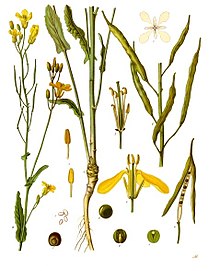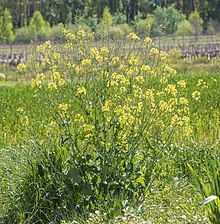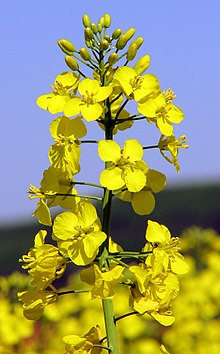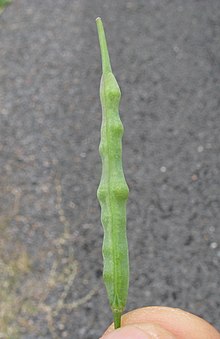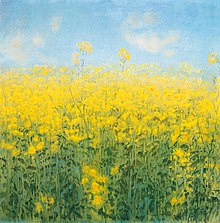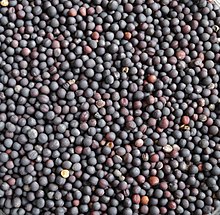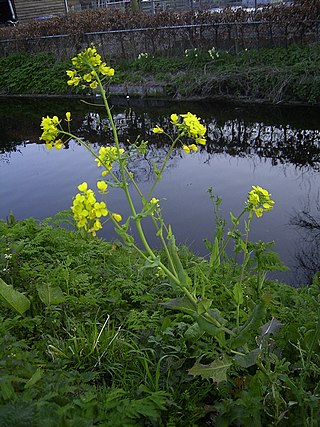
Brassica is a genus of plants in the cabbage and mustard family (Brassicaceae). The members of the genus are informally known as cruciferous vegetables, cabbages, mustard plants, or simply brassicas. Crops from this genus are sometimes called cole crops—derived from the Latin caulis, denoting the stem or stalk of a plant.

Vegetable oils, or vegetable fats, are oils extracted from seeds or from other parts of fruits. Like animal fats, vegetable fats are mixtures of triglycerides. Soybean oil, grape seed oil, and cocoa butter are examples of seed oils, or fats from seeds. Olive oil, palm oil, and rice bran oil are examples of fats from other parts of fruits. In common usage, vegetable oil may refer exclusively to vegetable fats which are liquid at room temperature. Vegetable oils are usually edible.
Erucic acid is a monounsaturated omega-9 fatty acid, denoted 22:1ω9. It has the chemical formula: CH3(CH2)7CH=CH(CH2)11CO2H. It is prevalent in wallflower seed and other plants in the family Brassicaceae, with a reported content of 20 to 54% in high erucic acid rapeseed oil and 42% in mustard oil. Erucic acid is also known as cis-13-docosenoic acid and the trans isomer is known as brassidic acid.
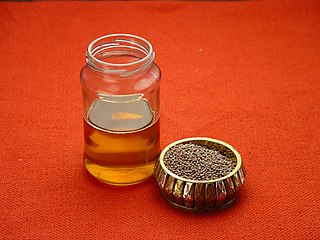
Mustard oil can mean either the pressed oil used for cooking, or a pungent essential oil also known as volatile oil of mustard. The essential oil results from grinding mustard seed, mixing the grounds with water, and isolating the resulting volatile oil by distillation. It can also be produced by dry distillation of the seed. Pressed mustard oil is used as cooking oil in some cultures, but sale is restricted in some countries due to high levels of erucic acid. Varieties of mustard seed also exist that are low in erucic acid.
Richard Keith Downey, is a Canadian agricultural scientist known for plant breeding and, as one of the originators of canola. He conducted his research at Agriculture and Agri-Food Canada (AAFC) and is largely responsible for transforming rapeseed into canola. His pioneering research has made him known as the "Father of Canola".

Brassica rapa is a plant species growing in various widely cultivated forms including the turnip ; Komatsuna, napa cabbage, bomdong, bok choy, and rapini.

Camelina sativa is a flowering plant in the family Brassicaceae usually known as camelina, gold-of-pleasure, or false flax, but also occasionally as wild flax, linseed dodder, German sesame, or Siberian oilseed. It is native to Europe and areas of Central Asia, but cultivated as an oilseed crop mainly in Europe and in North America. It is not related to true flax, in the family Linaceae.
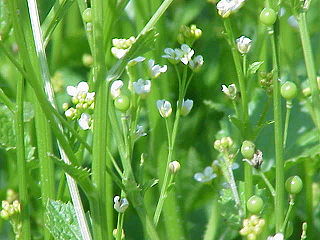
Crambe abyssinica is an annual oilseed crop of the family Brassicaceae. It is mainly cultivated due to the high levels of erucic acid that are contained in its seeds. The crambe oil is used for industrial purposes and its side products can be partly used as animal feed.
Leptosphaeria maculans is a fungal pathogen of the phylum Ascomycota that is the causal agent of blackleg disease on Brassica crops. Its genome has been sequenced, and L. maculans is a well-studied model phytopathogenic fungus. Symptoms of blackleg generally include basal stem cankers, small grey lesions on leaves, and root rot. The major yield loss is due to stem canker. The fungus is dispersed by the wind as ascospores or rain splash in the case of the conidia. L. maculans grows best in wet conditions and a temperature range of 5–20 degrees Celsius. Rotation of crops, removal of stubble, application of fungicide, and crop resistance are all used to manage blackleg. The fungus is an important pathogen of Brassica napus (canola) crops.
Verticillium longisporum, also known as Verticillium Wilt, is a fungal plant pathogen that commonly infects canola. V. longisporum can attack other brassica plants as well as woody ornamentals. A main symptom of the infected plant is wilting. In America, V. longsiporum primarily effects eudicot plants. This pathogen can be very devastating and hard to eradicate, responding only to expensive fumigation or fungal resistant plants.
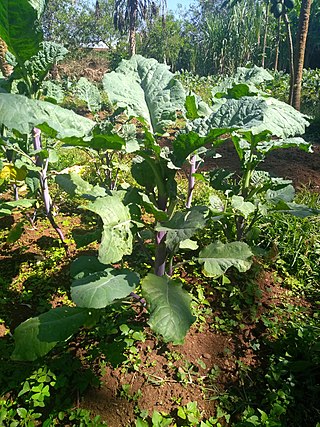
Brassica carinata is a species of flowering plant in the Brassicaceae family. It is referred to by the common names Ethiopian rape or Ethiopian mustard. It is believed to be a hybrid between Brassica nigra and Brassica oleracea.

Sinapine is an alkaloidal amine found in some seeds, particularly oil seeds of plants in the family Brassicaceae. It is the choline ester of sinapic acid.
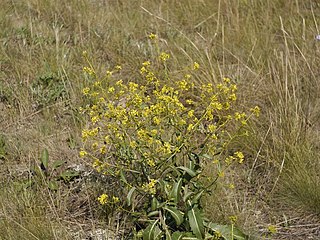
Brassica elongata, the elongated mustard or long-stalked rape, is a species of the mustard plant that is native to parts of Central Europe, Eastern Europe, the Balkan Peninsula, the Caucasus, Morocco and parts of Central Asia. Through plant invasion this species has become naturalized in many other parts of the world. Some of these naturalized regions include South Africa, North Western Europe, Australia and North America. Given the wide range of climate and ecological conditions of these regions, B. elongata has been able to disrupt the ecosystems of their native plant habitats and has been label as an invasive species in many of its naturalized zones. In North America, this species is often found as a roadside weed in the southwestern states, particularly in the state of Nevada. Studies allude that the Cruciferae might have migrated through the Bering land bridge from what is now Central Asia. Commonly known as the long-stalked rape or as langtraubiger Kohl in German, this species is a close cousin to Brassica napus (rapeseed) and a secondary genetic relative to B. oleracea (kale). As a close genetic species of the rapeseed, the long-stalked rape has one of the highest counts of accumulated polyunsaturated linoleic and linolenic acid. Both compounds are heavily used to manufacture vegetable oils. Brassica elongata has the propagative potential of turning into a horticultural product from what is currently a noxious weed.
Barbara Jane Howlett is an Australian fungal plant pathologist.
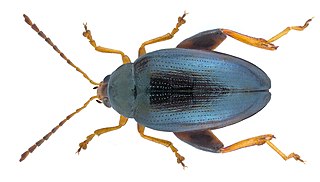
Psylliodes chrysocephala or Psylliodes chrysocephalus, commonly known as the cabbage-stem flea beetle, is a species of leaf beetle situated in the subfamily Galerucinae and the tribe Alticini.

Alternaria brassicicola is a fungal necrotrophic plant pathogen that causes black spot disease on a wide range of hosts, particularly in the genus of Brassica, including a number of economically important crops such as cabbage, Chinese cabbage, cauliflower, oilseeds, broccoli and canola. Although mainly known as a significant plant pathogen, it also contributes to various respiratory allergic conditions such as asthma and rhinoconjunctivitis. Despite the presence of mating genes, no sexual reproductive stage has been reported for this fungus. In terms of geography, it is most likely to be found in tropical and sub-tropical regions, but also in places with high rain and humidity such as Poland. It has also been found in Taiwan and Israel. Its main mode of propagation is vegetative. The resulting conidia reside in the soil, air and water. These spores are extremely resilient and can overwinter on crop debris and overwintering herbaceous plants.
Isobel Parkin is a Canadian research scientist with Agriculture and Agri-Food Canada. She is one of the world's premier canola scientists and her area of expertise focuses on brassica genomics, comparative genome organization, global gene expression analysis, and abiotic stress responses. She is well known for her work on an international project on the genetics of oil seeds, in particular the mapping and sequencing of the canola oil genome. She Co-lead the Canadian Canola Genome Sequence (CanSeq) team that successfully deciphered the canola genome and developed a high-quality genome sequence.
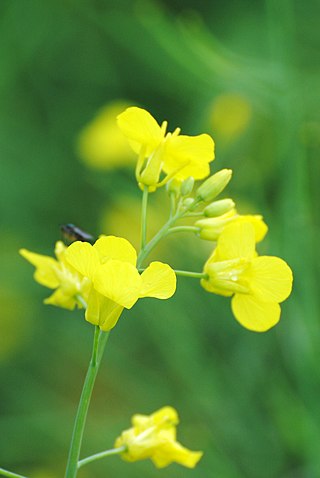
Rapeseed oil is one of the oldest known vegetable oils. There are both edible and industrial forms produced from rapeseed, the seed of several cultivars of the plant family Brassicaceae. Historically, it was restricted as a food oil due to its content of erucic acid, which in laboratory studies was shown to be damaging to the cardiac muscle of laboratory animals in high quantities and which imparts a bitter taste, and glucosinolates, which made many parts of the plant less nutritious in animal feed. Rapeseed oil from standard cultivars can contain up to 54% erucic acid.

Silvia Hildegard Haneklaus is a German agricultural scientist and researcher specialised in Plant nutrition and Soil science.
